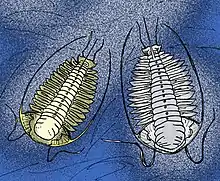Cloacaspis
Cloacaspis is an extinct genus of Olenid Ptychopariid trilobite. It lived during the early part of the Arenig stage of the Ordovician Period,[1] a faunal stage which lasted from approximately 478 to 471 million years ago. Richard Fortey has proposed that these particular trilobites lived in anoxic regions of the ocean floor, and cultivated symbiotic, sulfur-metabolizing bacteria.[3]
| Cloacaspis | |
|---|---|
 | |
| Cloacaspis senilis, and C. ekphymosa | |
| Scientific classification | |
| Kingdom: | |
| Phylum: | |
| Class: | |
| Order: | |
| Suborder: | |
| Superfamily: | Olenoidea |
| Family: | |
| Genus: | Cloacaspis |
Etymology
The generic name is a compound word from Latin, "cloaca," meaning sewer, and from Greek, "aspis," meaning "shield." Thus, Cloacaspis translate as "sewer shield." In his book, Trilobite! Eyewitness to Evolution, Fortey, who first discovered the genus in Ordovician strata in Spitsbergen, explained that the rocks they were found in had a rank, sulfurous odor, reminding him of raw sewage.[4]
References
- Sepkoski, Jack (2002). "A compendium of fossil marine animal genera (Trilobita entry)". Bulletins of American Paleontology. 364: 560. Archived from the original on 2006-09-05. Retrieved 2008-01-12.
- Fortey, R.A., "The Ordovician Trilobites of Spitsbergen"
- Fortey, Richard. Trilobite! Eyewitness to Evolution Random House Inc, 2001 p 70
- Fortey, Richard. Trilobite! Eyewitness to Evolution Random House Inc, 2001 p 69